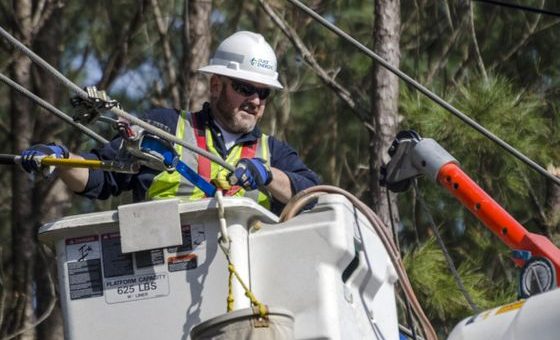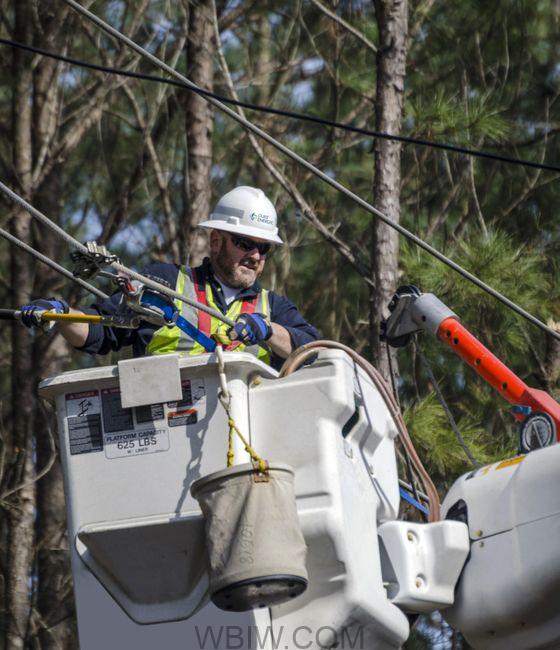
INDIANA – When severe weather rolls in or the lights go out, lineworkers mobilize. Their jobs are unlike any other – chasing storms, climbing poles, understanding the intricacies of the energy grid, and being prepared no matter the circumstances.
April 18th, Duke Energy celebrates National Lineworker Appreciation Day and the work these men and women do every day to keep the power flowing to millions of customers in communities across the country.
Line technicians are essential to providing and maintaining reliable electric service every day. They’re also lighting the way on our path to a clean energy future.

“Lineworkers are true heroes in our communities. If you know a line worker or see one working today, take a minute to thank them, whether they’re working near your home or in the community,” said Stan Pinegar, president of Duke Energy Indiana. “Our line workers’ dedication and skill make the difference to our customers and demonstrate Duke Energy at its best. We are grateful for their commitment to safety and our customers for the work they perform every day.”

In celebration of National Lineworker Appreciation Day, here are 9 facts you might not know about lineworkers:
- They wrestle wild weather. All line workers are trained to respond to major outages. Working in the aftermath of extreme weather such as severe storms and ice comes with the territory.
- Vital infrastructure is in their hands. Besides working to power homes, lineworkers are responsible for keeping the energy flowing to hospitals, schools, water treatment facilities, businesses, and industries.
- Clothes matter. While on the job, line technicians wear specific safety gear known as personal protection equipment (PPE). PPE can include hard hats, rubber sleeves and gloves (made to protect 30,000 volts of electricity), steel-toed boots, climbers for scaling poles, and climbing belts that can weigh up to 30 pounds each.
- It’s natural to aim high. Lineworkers frequently work perched on a 40-foot pole, sky-high in an elevated bucket truck, or on transmission towers at heights of up to 120 feet – often in challenging or hazardous conditions such as rain, winter weather, or sweltering heat. But no matter how extreme the situation – strict safety procedures are always in place.
- Technology is part of the toolkit. Lineworkers install self-healing smart technology that automatically detects power outages and quickly reroutes power when outages occur – which can help reduce the number of outages and the duration of an outage.
- Slang is standard. Have a knuckle-buster handy? What about a lobster claw, kettle, or booger wire? Lineworkers frequently use lingo for tools and tasks – it’s passed down from one generation of lineworkers to the next.
- Animals come with the job. A common cause of power outages is animal interference – especially squirrels and snakes.
- The tally is tremendous. In Indiana, 660 Duke Energy and contract lineworkers make up the team. They are responsible for constructing, operating, and maintaining equipment and more than 36,800 miles of transmission and distribution lines across the state.
- They’re shaping the grid of the future. Lineworkers are building a stronger, better protected, and smarter electric infrastructure, improving reliability and resiliency and preparing the grid for cleaner energy options and a lower carbon future.
Aglow with appreciation
During the week of April 18th, Duke Energy will be sharing special stories in appreciation of lineworkers. Make sure to follow @DukeEnergy and visit facebook.com/DukeEnergy.
Those who wish to honor lineworkers and their families for National Lineworker Appreciation Day are encouraged to use the hashtag #ThankALineworker on social media.
Duke Energy Indiana
Duke Energy Indiana, a subsidiary of Duke Energy, provides about 6,300 megawatts of owned electric capacity to approximately 870,000 customers in a 23,000-square-mile service area, making it Indiana’s largest electric supplier.



